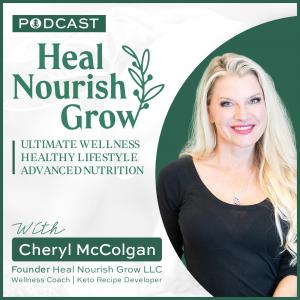Heal Nourish Grow Podcast

Stem Cells for Healing and Anti-Aging Benefits
Dr. Joy Kong shares her background and journey into stem cell therapy. She explains that stem cells can be used to treat a wide range of conditions, including autoimmune diseases, cardiovascular diseases, organ damage, and even sports injuries. Finding a properly trained doctor who uses native stem cells rather than expanded cells is very important and we discuss the best ways to find a qualified provider. Dr. Kong also discusses the challenges and resistance faced by stem cell therapy due to the current healthcare system and the influence of pharmaceutical companies. She encourages patients to be cautious when seeking treatment overseas and highlights the advancements and potential of stem cell therapy in the United States. Find Dr. Kong on her website and podcast. Her training for physicians is AAICT.org and you can buy her book here. Stem cell skincare, save 10 percent with code HealNourishGrow. Takeaways: Stem cell therapy can be used to treat a wide range of conditions, including autoimmune diseases, cardiovascular diseases, organ damage, and sports injuries. It is important to find a properly trained doctor who uses native stem cells rather than expanded cells. Stem cell therapy faces challenges and resistance due to the current healthcare system and the influence of pharmaceutical companies. Patients should be cautious when seeking treatment overseas and consider the advancements and potential of stem cell therapy in the United States. Watch on YouTube https://youtu.be/87jGMSMiqQc Transcript: Cheryl McColgan (00:01.023)Hey everyone, welcome back to the Heal and Nourish Grow podcast. Today I am joined by Dr. Joy Kong and she has a really interesting background, kind of this escape from China kind of story. And then now she's doing all this amazing work in stem cells. And I've just got so many questions about all that, but Dr. Kong, I would love it if you could share a little bit of your background first, because I think that that will… enable people to kind of understand where you're coming from and to get to know like why you're so passionate about your work now, what you had to do to get here. Joy Kong, MD (00:34.158)Right. Yeah. So I definitely have an interesting story. You know, up to age 20, I am one of the I don't know, half a billion Chinese women. I was just a Chinese girl with no money, no connections, not like my family had, you know, any high officials or any money. But I had a dream I wanted to come to this country because there's something that's really exciting and inspiring about the kind of freedom, the kind of accomplishment that you know, you can pursue. I don't know, it just sounds so exciting. So I decided no matter what, I'm gonna be there, I need to be there. So I was studying architecture and I decided to come to this country. I switched to biology because that's the only field that you could get a scholarship in, but I have diverse interests. So a lot of things interest me, which is probably why when I ended up finally going to medical school at UCLA, I specialized in psychiatry because the brain is so interesting, right? when you go into medicine is not a typical specialty that you think about psychiatry. We're kind of the, a bit of a in the medical community. We are all just a little weird, a little strange, a little something different. So, but my interest in medicine in the whole human body is still the same. I'm a passionate about human health, but the brain is fascinating. But if you just keep pounding on the brain looking at all the receptors and neurotransmitters and thinking that everything is related to brain structure, then you're missing the boat because you're not looking at your whole body. So when I was doing psychiatry while prescribing all these medications and doing some psychotherapy, I was trying to also improve my own health. I appreciate the body I was given and I want to do justice and want to do everything I can to...






 Visit Podcast Website
Visit Podcast Website RSS Podcast Feed
RSS Podcast Feed Subscribe
Subscribe
 Add to MyCast
Add to MyCast